Never before have so many children had lice. The number of children between the ages of 3 and 11 who have had lice has increased from 30 to 46% over the last eight years. Parents and schools are therefore encouraged to fight lice when children get back to school and other institutions and check their children for lice.
August is peak season for lice as many parents mistakenly believe that lice go on summer holidays with the children and don’t check their children for lice over the summer. Hence the risk of infecting others with lice is particularly high when children get back together after the summer.
Combing is the cheapest and most effective method
Regular combing of the hair with a fine comb has proven to be the most effective way to prevent and fight lice. A study conducted by the Department of Integrated Pest Management at Aarhus University showed that Danish lice have grown so resistant to common lice remedies that they do not die from them. Hence, researchers suggest combing the hair with a good lice comb to suppress the little beasts. One effective, cheap and completely harmless method is combing.
Get rid of lice!
If you find lice during combing you should act immediately and fight them. However, it matters which comb you use. Fine combs remove lice, eggs and egg shells and the teeth do not bend when you comb the hair. Nitcomb-M2 lice comb is an effective, fine comb that meets all three requirements. It was designed by pharmacists and has two rows of teeth and is hence twice as effective. The front row has small spaces between the teeth and catches large lice. The back row has extra-fine teeth and removes small lice, eggs and egg shells. The comb’s teeth are made of steel, which prevents them from bending when combing the hair. This prevents lice from slipping between the teeth and they are caught during combing. Furthermore, the steel teeth have rounded ends to avoid scraping the scalp.
Nitcomb-M2 lice comb is available in various girls’ and boys’ colours for a suggested retail price of DKK 69.95 at your pharmacy. Nitcomb-M2 lice comb has two rows of teeth and is hence twice as effective.


How to comb:
1. Rinse the hair thoroughly and massage the conditioner into the wet hair. When the hair is wet, the lice don’t move and cannot move to the spot that was just combed.
2. Comb the hair thoroughly with a normal comb. You cannot comb out lice if the hair is tangled.
3. Use the lice comb to comb the entire hair slowly and thoroughly for lice. Work systematically (use hairclips for thick or large hair) and start every stroke right at the scalp. Now pull the comb through the hair right to the ends of the strands. Continue until you no longer catch any lice. Repeat the combing throughout the entire hair and be particularly meticulous behind the ears and along the hairline. Be very meticulous where the hair is parted as well. Part the hair in different spots during combing.
4. Remember to use the lice comb correctly. The rounded ends should be pointing downwards.
5. Clean the comb after each stroke by drying off the comb’s teeth with a piece of moistened, white paper towel.
6. Carefully examine what you have combed out. Once you know what to look for, it’s easier to detect the lice.
7. Write down and plan. Did you comb out lice today and hence need to comb for the next two weeks? Or did you only find small nymphs and are therefore in the middle of the course? Or was it perhaps your last combing today? Remember to check once a week.
8. Finish off by rinsing out the conditioner and cleaning the comb thoroughly.
Facts about lice
Head lice can only survive in head hair close to the scalp where they suck blood and live in a nice moist, warm environment. Young children (3-11 years old) most often get lice, but ANYONE with head hair longer than 0.5 cm can get lice. Head lice are approx. 3 mm long and greyish. They live on the scalp and attach their eggs to the hairs. Adult lice can live for up to three weeks, during which the female lice deposit approx. 5-8 eggs a day. Head lice are spread through direct contact and by wandering from one head to another. Girls get them more often than boys because they often have longer hair. It doesn’t matter if the hair is clean or dirty. Lice live on humans; they cannot live on animals.
For more information, please visit:
mail@pharmavest.dk
www.pharmavest.dk
